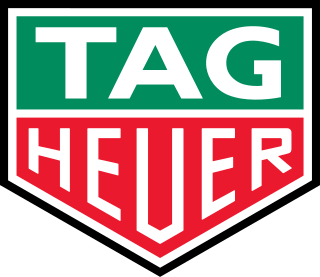
A watch is a portable timepiece intended to be carried or worn by a person. It is designed to keep a consistent movement despite the motions caused by the person's activities. A wristwatch is designed to be worn around the wrist, attached by a watch strap or other type of bracelet, including metal bands, leather straps, or any other kind of bracelet. A pocket watch is designed for a person to carry in a pocket, often attached to a chain.

Seiko Group Corporation, commonly known as Seiko, is a Japanese maker of watches, clocks, electronic devices, semiconductors, jewelry, and optical products. Founded in 1881 by Kintarō Hattori in Tokyo, Seiko introduced the world's first commercial quartz wristwatch in 1969.

TAG Heuer S.A. is a Swiss luxury watchmaker. The company began as Uhrenmanufaktur Heuer AG, founded in 1860 by Edouard Heuer in St-Imier, Switzerland. In 1985, TAG Group purchased a majority stake in the company, forming TAG Heuer. In 1999, French luxury goods conglomerate LVMH bought nearly 100 percent of the Swiss company.The name TAG Heuer combines the initials of "Techniques d'Avant Garde" and the founder's surname.

A stopwatch is a timepiece designed to measure the amount of time that elapses between its activation and deactivation.

Patek Philippe SA is a Swiss luxury watch and clock manufacturer, located in the Canton of Geneva and the Vallée de Joux. Established in 1839, it is named after two of its founders, Antoni Patek and Adrien Philippe. Since 1932, the company has been owned by the Stern family in Switzerland and remains the last family-owned independent watch manufacturer in Geneva. Patek Philippe is one of the oldest watch manufacturers in the world with an uninterrupted watchmaking history since its founding. It designs and manufactures timepieces as well as movements, including some of the most complicated mechanical watches. The company maintains over 400 retail locations globally and over a dozen distribution centers across Asia, Europe, North America, and Oceania. In 2001, it opened the Patek Philippe Museum in Geneva.

A chronograph is a specific type of watch that is used as a stopwatch combined with a display watch. A basic chronograph has an independent sweep second hand and a minute sub-dial; it can be started, stopped, and returned to zero by successive pressure on the stem. More complex chronographs use additional complications and can have multiple sub-dials to measure seconds, minutes, hours and even fractions of a second. In addition, many modern chronographs use moveable bezels as tachymeters for rapid calculations of speed or distance. Louis Moinet invented the chronograph in 1816 for use in tracking astronomical objects. Chronographs were also used heavily in artillery fire in the mid to late 1800s. More modern uses of chronographs involve aircraft piloting, auto racing, diving and submarine maneuvering.

Valjoux is a Swiss manufacturer of mechanical watch movements. It is known primarily for chronograph ébauche movements that are used in a number of mid- to high-range mechanical watches. The company is a part of ETA, and is a member of the Swatch Group. They are also the movement providers for early Rolex Daytonas such as 6263.

ETA SA Manufacture Horlogère Suisse designs and manufactures quartz watches and both hand-wound and automatic-winding mechanical ébauches and movements. Commonly referred to as ETA, the company is headquartered in Grenchen, Switzerland, and is a wholly owned subsidiary of The Swatch Group.

In horology, a complication is any feature of a timepiece beyond the display of hours, minutes and seconds. A timepiece indicating only hours, minutes and seconds is known as a simple movement. Common complications include date or day-of-the-week indicators, alarms, chronographs (stopwatches), and automatic winding mechanisms. Complications may be found in any clock, but they are most notable in mechanical watches where the small size makes them difficult to design and assemble. A typical date-display chronograph may have up to 250 parts, while a particularly complex watch may have a thousand or more parts. Watches with several complications are referred to as grandes complications.

A flyback chronograph is a watch complication, in which the user can use a reset function without the need to first stop the chronograph, by a single press on an additional pusher at the 4 o’clock mark. In usual chronographs of the time, the user had to push three times for the same operation. First they had to stop the chronograph, then reset the hands at zero, and finally restart the chronograph in order to time the next sequence. A flyback chronograph shortens the time of operation needed to measure subsequent legs of a flight.

A mechanical watch is a watch that uses a clockwork mechanism to measure the passage of time, as opposed to quartz watches which function using the vibration modes of a piezoelectric quartz tuning fork, or radio watches, which are quartz watches synchronized to an atomic clock via radio waves. A mechanical watch is driven by a mainspring which must be wound either periodically by hand or via a self-winding mechanism. Its force is transmitted through a series of gears to power the balance wheel, a weighted wheel which oscillates back and forth at a constant rate. A device called an escapement releases the watch's wheels to move forward a small amount with each swing of the balance wheel, moving the watch's hands forward at a constant rate. The escapement is what makes the 'ticking' sound which is heard in an operating mechanical watch. Mechanical watches evolved in Europe in the 17th century from spring powered clocks, which appeared in the 15th century.
Miyota is a brand of mechanical and quartz watch movements manufactured by Citizen Watch Manufacturing Co., Ltd. (CWMJ), a subsidiary of Citizen Watch.

Bovet Fleurier SA is a Swiss brand of luxury watchmakers chartered 1 May 1822 in London, UK by Édouard Bovet. It is most noted for its pocket watches manufactured for the Chinese market in the 19th century. Today it produces high-end artistic watches with a style that references its history. The company is known for its high-quality dials, engraving and its seven-day tourbillon. The original Bovet watches were also among the first to emphasize the beauty of their movements with skeletonized views and highly decorative movements. Bovet watches were also among the first to include a second hand while the company has a tradition of employing women artisans, which is rare for traditional watch making companies in Europe. Pascal Raffy is the current owner.

Gérald Charles Genta was a Swiss watchmaker and artist. He is known for his eponymous lines of timepieces, such as Gerald Genta and Gerald Charles, as well as his design work with other high-end watch manufacturers, including IWC, Omega, Universal Genève, Patek Philippe and Audemars Piguet. Genta created the Patek Phillipe Nautilus and the Audemars Piguet Royal Oak, to date, the best-selling models of both houses. He is regarded as one of the most influential people in the history of horology.

Gallet (ˈgæl.eɪ) is a historic Swiss manufacturer of high-end timepieces for professional, military, sports, racing, and aviation use. Gallet is the world's oldest clock making house with history dating back to Humbertus Gallet, a clock maker who became a citizen of Geneva in 1466. The Gallet & Cie name was officially registered by Julien Gallet (1806–1849) in 1826, who moved the family business from Geneva to La Chaux-de-Fonds, Switzerland. Prior to this date, operations commenced under the name of each of the Gallet family patriarchs.

Abraham-Louis Perrelet was a Swiss horologist. He was born in Neuchâtel, then in the Principality of Neuchâtel.

The Breitling Chronomat was initially released in 1941 in Switzerland by Breitling SA. Since then it has been one of the best selling watches produced by Breitling. Its set of four bezel rider tabs became a Breitling signature design detail, seen as well in the Breitling Colt. Chronomat is a trademark and collection line first released in 1942, and is one of the company's best-selling models.

The Omega Electroquartz was introduced in 1969 as the first production Swiss quartz watch. It was the collaboration of 20 Swiss watch companies and the movement was utilised by Rolex, Patek Phillipe and Omega amongst others. The Beta 21 movement used in the Electroquartz was accurate to 5 seconds per month, far better than any automatic or manual wind movement of the day.

















